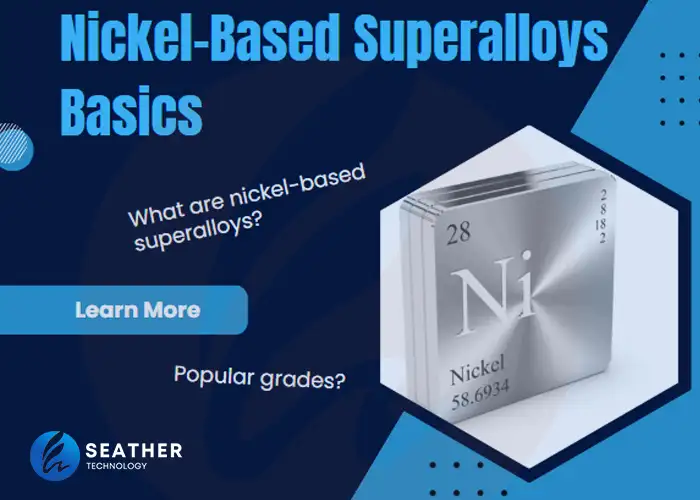Stainless steel is an iron-based alloy that contains chromium and nickel as the main alloy elements, along with other elements such as carbon, magnesium, sulfur, titanium, molybdenum, copper, and nitrogen.
Stainless steel is mostly used as a basic part of industries such as construction, automotive, military, and medical sectors due to its outstanding durability, strength, and corrosion resistance.
Nickel-based alloys have more nickel, chromium, and molybdenum contents than stainless steel.
This article guide will cover all the differences, properties, and applications of these two well-known alloys.
Let’s keep reading.

Stainless steel is an alloy that includes 10.5% chromium, 0.35% carbon, 8%nickel, and some carbon mixed with iron.
However, the manufacturer can change the composition according to their needs.
Chromium has a critical role in preventing rust from destroying steel. Its strength and flexibility come from nickel, and its special properties come from carbon.
Stainless steel is special because austenite requires a certain amount of carbon. For austenitic stainless steel, a specific amount of carbon is necessary because it gives unique properties.
What is Nickel-Based Alloy?

Although nickel-based alloys have exceptional strength, heat resistance, and corrosion resistance, they are also known as nickel-based superalloys.
The Nickel-based alloys are characterized by their face-centered crystal structure.
Compared to iron and steel, nickel-based alloys were created to offer higher strength at high temperatures and greater resistance to corrosion.
Although nickel alloys are far more expensive than ferrous metals, given their extended lifespan, they might be the most economical long-term material choice. The elements molybdenum, chromium, nickel, and other components are balanced in these alloys.
Material Performance in Various Environments
Stainless steel and nickel-based alloys are mostly used in a variety of environments, but nickel-based alloys are generally more suitable for extreme environmental conditions due to their outstanding properties.
Stainless steel is typically employed in room-temperature applications. Nickel alloys such as Inconel, Incoloy, and Hastelloy are primarily employed in high-temperature applications.
Strength and Durability of Stainless Steel vs Nickel Based Alloy
Tensile Strength
Both stainless-steel and nickel-based alloys have excellent tensile strength. However, nickel-based alloys, particularly those intended for high-temperature applications, have better tensile strength than stainless steel.
Fatigue Strength
Nickel-based alloys have extra nickel and chromium contents; therefore, these alloys show excellent fatigue strength compared to stainless steel under high-temperature conditions.
Impact Resistance
Impact strength refers to a material’s capacity to withstand cracking, fracturing, and deformation when subjected to a quick and severe impact. Regarding impact strength, nickel-based alloys outperform steel due to their unique strength, ductility, and resistance to fracture and cracking.
Wear Resistance
A material’s resistance to indentation, scratching, cutting, and bending is called wear resistance. Nickel-based alloys offer higher wear resistance than stainless steel due to their superior hardness, strength, and durability.
Hardness
The different grades of stainless steel have different levels of hardness according to their composition. Nickel-based alloys have better hardness than stainless steel and are mostly used in applications that demand more strength and hardness. Hardness is also increased by special heat treatment processes.
Yield Strength
The yield point on a stress-strain curve represents the end of the elastic activity and the beginning of plastic behavior in materials science and engineering. Nickel-based alloys have higher yield strength than stainless steel due to their greater hardness and endurance.
Formability and Machinability of Stainless Steel vs Nickel Based Alloy
Stainless Steel Formability
Because of its interesting range of mechanical properties, stainless steel shows excellent formability and is mostly used in forming applications. The material’s high strength-to-weight ratio, as well as its considerable elongation and work-hardening properties, mean that it can often meet the challenges of complex, three-dimensional, seamless designs.
Nickel Based Alloy Formability
Nickel-based alloys offer great formability and manufacturing ease, making it easy to turn them into various shapes. The exceptional formability of nickel-based alloys is due to their unique blend of high strength and workability.
Stainless Steel Machinability
Different grades of stainless show different machinability, but most of the grades have good machinability. The grade 303 is most easy to machine in the 300 stainless steel series.
Nickel Based Alloy Machinability
Nickel-based alloys have remarkable high-temperature strength and significant toughness, which make machining problematic; the work-hardening tendency in very high cutting forces and substantial burr formation during machining.
Stainless Steel Weldability
The majority of stainless steel grades are highly weldable, allowing for the clean, watertight, and permanent assembly of complicated systems from individual pieces. Welded areas have changing corrosion properties that must be taken into consideration.
Nickel Based Alloy Weldability
Nickel-based alloys are easily welded; however, the surface must be cleaned carefully before welding. The typical cleaning procedure is to degrease the surface, remove any surface oxide by machining, grinding, or scratch brushing, and finally degrease.
Bending Characteristics
Stainless steel and nickel-based alloys are ductile and may be shaped into a variety of forms and sizes. They are also extremely flexible, meaning they can be bent and formed without cracking or breaking.
Deep Drawing Capability
Stainless steels are commonly deep-drawn into complex geometries, generally without intermediate annealing. They are exceedingly formable, and austenitic grades have much better ductility than carbon steels. Nickel-based alloys also have outstanding deep drawing capabilities, making them appropriate for a wide range of applications.
Cutting Ease
The cutting ease for stainless steel and nickel-based alloys depends upon the different grades due to the variations in chemical composition. Overall, stainless steel is easier to cut than nickel-based alloys.
Stainless Steel Vs Nickel-Based Alloy – Differences in Weldability
Melting Point
As with other alloys, the melting point of stainless steel and nickel-based alloys is expressed as a range of temperatures rather than a single value. The temperature range for stainless steel is 1,400 to 1,530 °C, while for nickel-based alloys, it is 1200 to 1,430 °C. This can change depending on the composition of the grades.
Thermal Conductivity
Nickel alloys do not have very good heat conductivity. However, low thermal conductivity is frequently needed in high-temperature applications to reduce heat transmission to other components. On the other hand, stainless steel also has a low heat conductivity of approximately 15 W/(mK).
Electrical Conductivity
Nickel alloys and stainless steel grades have significantly lower electrical conductivity than pure copper, aluminum, or silver.
Weight
While stainless steel and nickel alloys are frequently favored for strength and corrosion resistance, their high density makes them unsuitable for lightweight equipment in many circumstances.
Corrosion Resistance
The presence of chromium in stainless steel makes it highly resistant to corrosion and rust. On the other hand, Nickel alloys are highly resistant to chloride ion stress corrosion cracking, pitting, and crevice corrosion, making them ideal for use in conditions where other materials would degrade rapidly.
Welding Techniques
Generally, various stainless steel grades are highly weldable, allowing for assembling complicated systems from individual components. Nickel-based alloys can be welded using the MIG (metal inert gas) or TIG (tungsten inert gas) methods. They can also be linked with manual metal arc welding (MMA).
Weld Joint Preparation
It is very important to clean the parts that are to be welded. The surface and welding edges of the parts must be free from oil, grease, or dirt for a perfect welding joint.
Weld Appearance
Stainless steel and nickel-based alloys are frequently praised for their attractive visual qualities. Its clean, polished appearance provides a feel of elegance to a variety of applications, including architectural projects, decorative elements, and kitchen equipment.
Cost
Due to the high cost of nickel and other alloying components, nickel alloys are more expensive than stainless steel. As a result, they are frequently limited to high-performance applications, such as those in the aerospace sector.
Weight and Density Comparison

Density of Stainless Steel
As mentioned above, stainless steel is divided into four categories or families. Each family has different densities due to the different compositions. The density of stainless steel value ranges from 7.75 to 8.05 grams per cubic centimeter g/cm³ for all grades.
The density of 304-grade stainless steel is about 7930 kg/m3 or 7.93 g/cm3. The density of 304 is less than 316 and slightly more than grade 430 stainless steel, which is 7.75 g/cm3.
Density of Nickel-Based Alloy
Nickel-based alloys have varied density values depending on their composition. Alloy 625 has a density of 8.44 g/cm³, compared to 8.9 g/cm³ for Alloy C-276.
Applications and Industries
Applications of stainless steel
Some common applications of stainless steel are given below.
Kitchen Utensils & Appliances
A popular material for all types of kitchen equipment is stainless steel. It is a strong, long-lasting substance that is suitable for heavy-duty, continuous use in the kitchen.
Medical equipment
In the medical sector, stainless steel is most commonly used for making different types of equipment and gadgets, such as surgical and dental instruments.
Automotive industry
Stainless steel is generally strong, long-lasting, and corrosion-resistant; therefore, it is a popular choice for many automotive parts. It is utilized in gasoline tanks, exhaust systems, and exterior finishing and decorative purposes.
Applications of nickel-based alloy
Chemical processing
Chemical processing industries frequently require materials that are extremely resistant to corrosive conditions. Nickel alloys are extremely corrosion resistant, especially when combined with elements like chromium and nickel. Tanks, pipes, and mixing equipment are some examples of common applications.
Marine equipment
Nickel alloys are more suitable for marine applications because marine conditions are extremely corrosive. Many alloys cannot resist long-term exposure to salt water. Bilge pumps, Propellers, and valves are some common examples of marine applications.
Conclusion
Both of these materials perform well in their specific applications due to their outstanding properties.
Before selecting a material or specific alloy for your project, keep in mind all the requirements, such as temperature limitation, environmental conditions, weight, and strength.
As the leading alloy supplier in China, we invite you to reach out for any inquiries. Our sales expert team is dedicated to providing you with the best service possible.






